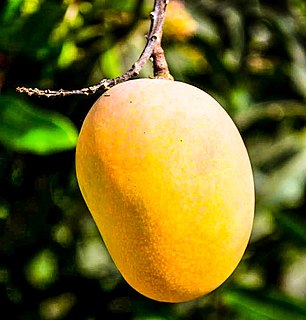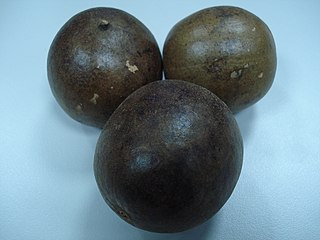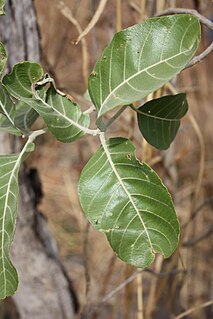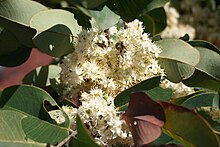
A mango is an edible stone fruit produced by the tropical tree Mangifera indica which is believed to have originated from the region between northwestern Myanmar, Bangladesh, and northeastern India. M. indica has been cultivated in South and Southeast Asia since ancient times resulting in two distinct types of modern mango cultivars: the "Indian type" and the "Southeast Asian type". Other species in the genus Mangifera also produce edible fruits that are also called "mangoes", the majority of which are found in the Malesian ecoregion.

The pomegranate is a fruit-bearing deciduous shrub in the family Lythraceae, subfamily Punicoideae, that grows between 5 and 10 m tall.

A melon is any of various plants of the family Cucurbitaceae with sweet, edible, and fleshy fruit. The word "melon" can refer to either the plant or specifically to the fruit. Botanically, a melon is a kind of berry, specifically a "pepo". The word melon derives from Latin melopepo, which is the latinization of the Greek μηλοπέπων (mēlopepōn), meaning "melon", itself a compound of μῆλον (mēlon), "apple, treefruit " and πέπων (pepōn), amongst others "a kind of gourd or melon". Many different cultivars have been produced, particularly of cantaloupes.

Guava is a common tropical fruit cultivated in many tropical and subtropical regions. The common guava Psidium guajava is a small tree in the myrtle family (Myrtaceae), native to Mexico, Central America, the Caribbean and northern South America. The name guava is also given to some other species in the genus Psidium such as strawberry guava and to the pineapple guava, Feijoa sellowiana. In 2019, 55 million tonnes of guavas were produced worldwide, led by India with 45% of the total. Botanically, guavas are berries.

Jujube, sometimes jujuba, known by the scientific name Ziziphus jujuba and also called red date, Chinese date, and Chinese jujube, is a species in the genus Ziziphus in the buckthorn family Rhamnaceae.

The jackfruit, also known as jack tree, is a species of tree in the fig, mulberry, and breadfruit family (Moraceae). Its origin is in the region between the Western Ghats of southern India, all of Sri Lanka and the rainforests of the Philippines, Indonesia, and Malaysia.

Aegle marmelos, commonly known as bael, also Bengal quince, golden apple, Japanese bitter orange, stone apple or wood apple, is a rare species of tree native to the Indian subcontinent and Southeast Asia. It is present in India, Bangladesh, Sri Lanka, Nepal as a naturalized species. The tree is considered to be sacred by Hindus.

Spondias purpura is a species of flowering plant in the cashew family, Anacardiaceae, that is native to tropical regions of the Americas, from Mexico to Brazil. It is also very common in most of the Caribbean islands. It is commonly known as jocote, which derives from the Nahuatl word xocotl, meaning any kind of sour or acidic fruit. Other common names include red mombin, plum, purple mombin, hog plum, ciriguela, ceriguela, seriguela, siriguela (Brazil) ciruela huesito (Colombia), ciruela, ciruela traqueadora (Panama), ciriguela, cirigüela, cirguela, cirguelo (Ecuador), and siniguelas (Philippines). It is a popular fruit throughout Central America, particularly in El Salvador, Nicaragua, Honduras and in Costa Rica.

Siraitia grosvenorii, also known as monkfruit or luohan guo, is a herbaceous perennial vine of the gourd family, Cucurbitaceae. It is native to southern China and northern Thailand. The plant is cultivated for its fruit extract, called mogrosides, which creates a sweetness sensation 250 times stronger than sucrose. Mogroside extract has been used as a low-calorie sweetener for drinks and in traditional Chinese medicine.

Irvingia gabonensis is a species of African trees in the genus Irvingia, sometimes known by the common names wild mango, African mango, or bush mango. They bear edible mango-like fruits, and are especially valued for their fat- and protein-rich nuts.

An orange is a fruit of various citrus species in the family Rutaceae ; it primarily refers to Citrus × sinensis, which is also called sweet orange, to distinguish it from the related Citrus × aurantium, referred to as bitter orange. The sweet orange reproduces asexually ; varieties of sweet orange arise through mutations.

Borassus flabellifer, commonly known as doub palm, palmyra palm, tala or tal palm, toddy palm, wine palm or ice apple is native to the South Asia and Southeast Asia. It is reportedly naturalized in Socotra and parts of China.

Detarium senegalense is a leguminous tree in the subfamily Detarioideae. Unlike most members of the family, it produces globular fruits. Its common names include ditax, ditakh, detar, and tallow tree. The tree is of value for several reasons: the fruit is nutritious, is locally prominent in folk medicine, and is a source of quality timber. It could contribute to food security, sustainable land care, and rural development. As its Linnaean name indicates, it is native to Senegal and the surrounding countries of West Africa.

An apple is an edible fruit produced by an apple tree. Apple trees are cultivated worldwide and are the most widely grown species in the genus Malus. The tree originated in Central Asia, where its wild ancestor, Malus sieversii, is still found today. Apples have been grown for thousands of years in Asia and Europe and were brought to North America by European colonists. Apples have religious and mythological significance in many cultures, including Norse, Greek, and European Christian tradition.

Parkia biglobosa, also known as the African locust bean, is a perennial deciduous tree of the family Fabaceae, in the genus Parkia. It is found in a wide range of environments in Africa and is primarily grown for its pods that contain both a sweet pulp and valuable seeds. Where the tree is grown, the crushing and fermenting of these seeds constitutes an important economic activity. Various parts of the locust bean tree are used for medicinal and food purposes. As a standing tree, locust bean may have a positive effect on the yield of other nearby crops.

Combretum glutinosum is a shrub species of the genus Combretum, found in the Sahel belt in parts of Senegal, Burkina Faso, Ghana, Mali, the Gambia, Niger, Nigeria and Cameroon, across to parts of Sudan. It is known as dooki in Pulaar, Kantakara in Hausa, rat in Wolof and jambakatan kè in Maninka. Its synonyms are Combretum cordofanum Engl. & Diels, C. passargei Engl. & Diels, C. leonense Engl. & Diels.

Abutilon fruticosum is a widespread species of flowering plant in the mallow family known by the common names Texas Indian mallow, pelotazo, and sweet Indian mallow. It is native to Africa, southern and southwestern Asia, northern Mexico, and the south-central United States.

Ceratotheca sesamoides is a flowering plant in the genus Ceratotheca. It is indigenous to Africa and grows both as a wild weed and locally cultivated species, and is colloquially referred to as false sesame owing to its marked similarities with common sesame. The plant is most commonly cultivated in the African Savannah and other semi-arid areas on the continent and is found across Africa in both tropic and sub-tropic regions, usually growing in sandier soils south of the Sahara. It can be identified by numerous hairs on the stem, its pink flowers often replete with brown and purple dots and a sub-erect growth habit. A plant with many practical uses, the leaves and flowers are often consumed as vegetables or used in sauces. The leaves can also have medicinal benefits while the seeds can be employed to produce cooking oil. Despite its many uses and growing domestication at a local level, the plant remains predominantly underused and undervalued.

Syzygium alternifolium is a species of plant in the family Myrtaceae. It is native to North Arcot, Cuddapah, Kurnool, and the Nagari hills, in eastern Chittoor district, India. It has alternate leaves.

Palm fruit juice or Tal er Rosh, is sweet sap extracted from the fruit of palm trees in summer. It contains vitamins A, B, C, and the elements zinc, calcium, potassium, and iron. It also contains antioxidants. This is a symbolic and well-known food in Bengal in the summer. Numbers of popular Bengali foods are made using this palm fruit juice such as palm candy, pitha, pays, kheer, and taller boora.




















